Understanding Your Basal Body Temperature: Easy Guide and FAQs
What Is the Normal Body Basal Temperature?
Technically, there’s no fixed “normal” basal body temperature(BBT). It’s simply your body temperature at rest and should be measured immediately after waking up.
According to Dr. Niels van de Roemer(PhD), Daysy's medical expert, “During sleep, a temperature minimum is established in the body core (the base), which is called basal temperature (formerly also ovarian temperature). In practice, the core body temperature upon waking is often referred to as the basal temperature.”
Essentially, your body resets your temperature when you get sufficient sleep. Check your BBT chart, and you’ll see that it’s not constant but varies within a narrow range. BBT typically shows a biphasic pattern that matches the two phases of your menstrual cycle, and your hormones are responsible. Let’s walk you through the process.
Each menstrual cycle features two key parts called the follicular and luteal phases. Day one of your period ushers the first part (follicular phase) of each cycle. As the name implies, multiple follicles in your ovary develop during this period. Ultimately, only one reaches maturity and is released during ovulation, thus ending the follicular phase.
You’ll see on your BBT chart that your temperature readings are slightly lower during the first part of your cycle. Estrogen, which controls the events of this phase, lowers your basal temperature. Before ovulation, many women record basal temperatures between 97°F (36.1°C) and 97.5°F (36.4°C).
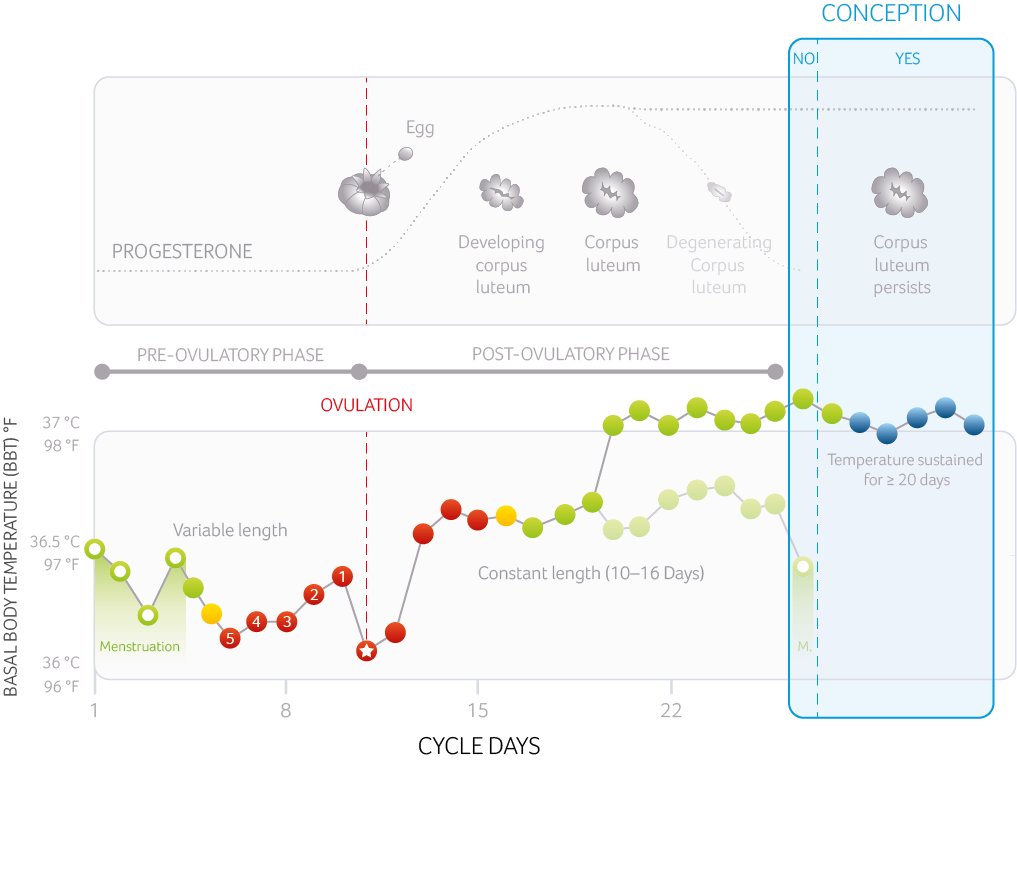
Right after ovulation, you’ll see a slight upward shift of about 0.9 °F (0.2 °C) in your BBT chart. This begins the luteal phase of your menstrual cycle. It gets its name from a newly formed gland called the corpus luteum. This is the remnant of the follicle after egg release that produces mainly progesterone after ovulation.
In addition to maintaining your endometrium, progesterone boosts your baseline temperature. It acts on the hypothalamus and thyroid gland to increase your body temperature. This is why your BBT is a little higher after ovulation.
What if you see two peaks on your BBT chart?
Some women may experience two temperature rise points in their BBT, but this might not show up on the chart. The first peak may occur immediately after ovulation, while the second one may appear roughly 6 to 12 days after ovulation.
Implantation of the embryo in the uterus may be responsible for the second BBT peak. This triphasic BBT curve could be an early pregnancy sign. Keep in mind that implantation doesn’t always cause a second BBT peak, so you can only confirm that by taking a pregnancy test.[1]
Another temperature pattern some women observe is the monophasic BBT curve. This means there are no temperature spikes — a single temperature phase throughout. It’s usually a sign that ovulation didn’t occur (anovulation). No ovulation means the corpus luteum doesn’t form, so you won’t get the progesterone surge that warms you up in the second phase of your cycle.
10 to 15% of all cycles are anovulatory ( Study ). They’re more common at the start of puberty and toward menopause. If you experience them more than thrice a year, speak with your doctor. Factors such as Polycystic ovary syndrome (PCOS), stress, and thyroid disorders are linked to anovulatory cycles.[2]
You can tell when and how frequently ovulation fails to occur if you’re tracking your cycle with the Daysy fertility tracker. If it happens often, you should discuss it with your healthcare provider, especially if you’re trying to have kids.

What Is the Basal Body Temperature Range When Pregnant?
A pregnant woman typically has a higher body temperature than she had before pregnancy due to progesterone. The temperature change isn’t drastic, so you shouldn’t have a fever. On average it rises about 0.4 to 0.5°F (0.2 to 0.3°C), so your BBT may increase to 97.4°F (37°C) from 97°F (36.6°C). This range is similar to what you see after ovulation, but it lasts longer in this case. A BBT spike for longer than 18 days could be an early sign of pregnancy, but you still have to confirm it by taking a pregnancy test.
Here’s how pregnancy affects your BBT:
After ovulation, your basal temperature peaks as you move into the second phase of your menstrual cycle. If you get pregnant, the corpus luteum remains functional for roughly the first trimester. The placenta produces HCG to maintain the corpus luteum during this period. And in turn, the corpus luteum produces progesterone which sustains your uterine lining to support the pregnancy. It also makes you a little warmer.
Around week 10 of pregnancy, the corpus luteum begins to shrink. Usually, by week 12, it stops producing progesterone and is degraded. Nevertheless, progesterone is still crucial for sustaining a pregnancy. It helps your uterus expand to accommodate the growing fetus and prevents early pregnancy loss. With the corpus luteum out of the way, progesterone production switches to the placenta. This is about the same time some pregnant women see their BBT change. It might drop a little, but this isn’t true for everyone. BBT generally remains elevated throughout pregnancy.
Should You Monitor Your Pregnancy by Tracking Your BBT?
It’s entirely up to you to decide if you want to track your BBT during pregnancy. Your chart may help you visualize your pregnancy progress, especially during the first trimester. Keep in mind that some pregnant women may observe that their BBT fluctuates, but according to Dr. van de Roemer, that doesn’t necessarily mean anything is wrong.
Set your fertility tracker aside during your pregnancy, and you can return to using it again after your baby arrives. Six weeks after childbirth is a great time to get back to using your Daysy fertility tracker. This is around the time you get your first period. Your first period may arrive anywhere between five weeks to a year after childbirth.
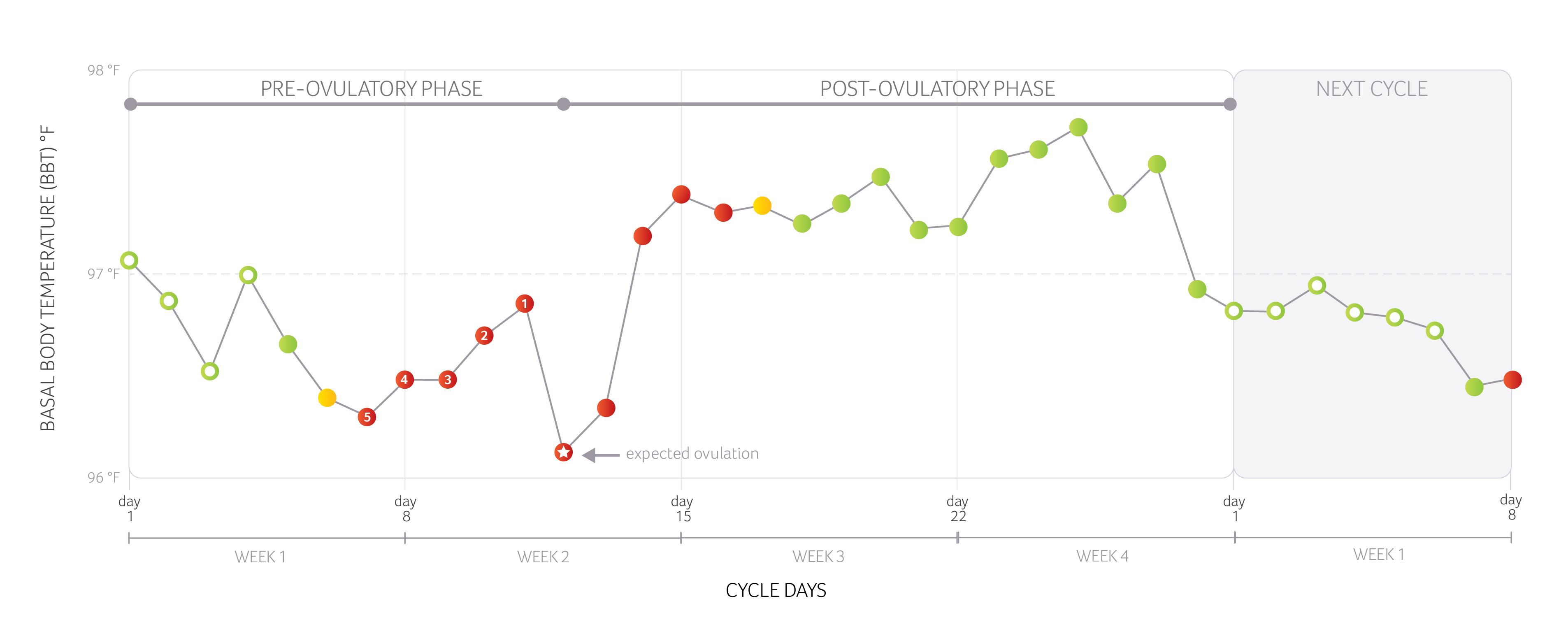
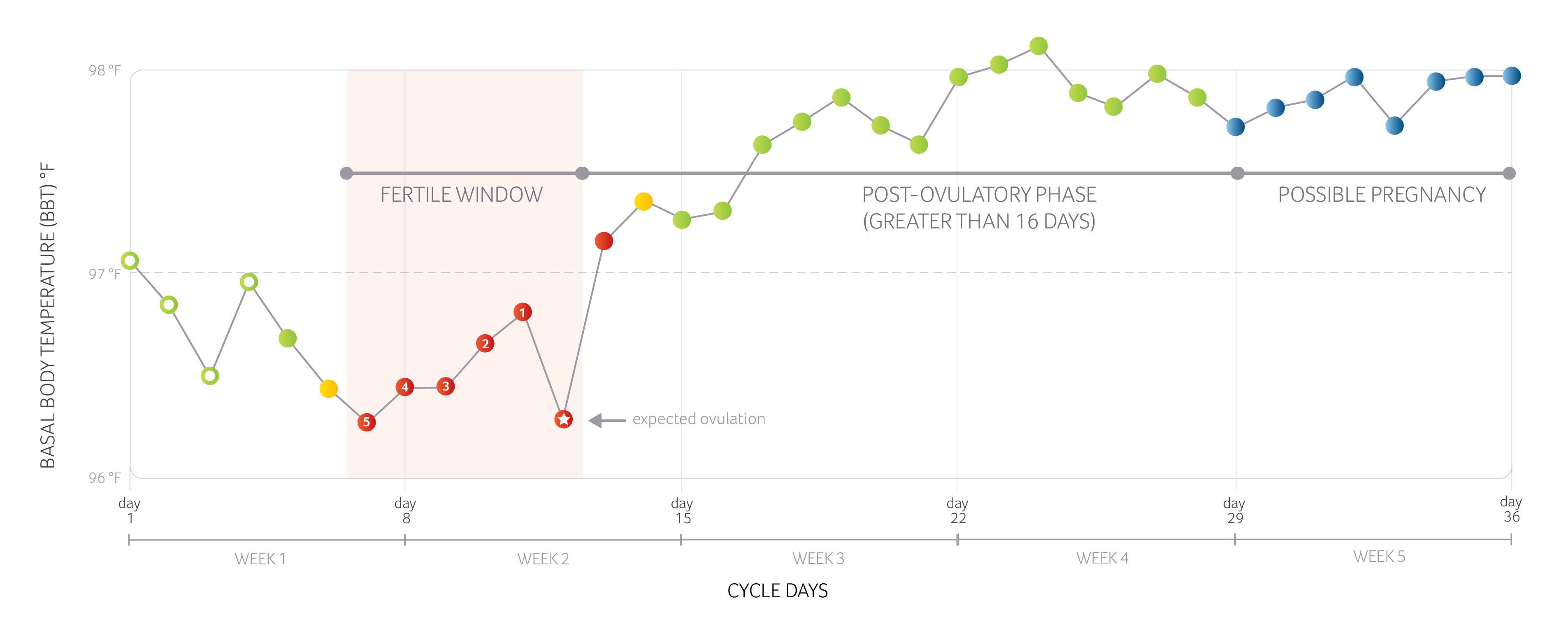
Does Basal Body Temperature Rise Before a Period?
Your basal body temperature(BBT) increases by about 0.4 to 0.5°F (0.2 to 0.3°C) immediately after ovulation due to progesterone from the corpus luteum. For the two weeks leading to your period, it stays relatively constant at a high level. But a few days before menstruation, your BBT begins to decline.
Here’s a breakdown of the process:
Your menstrual cycle has two key stages — follicular and luteal phases. At the start of the follicular phase, you get your period, and at the end, you release an egg (ovulation). Your BBT also follows a similar pattern.
Low-level BBT coincides with the follicular phase of your menstrual cycle. On the other hand, the high-level BBT matches the luteal phase of your cycle.
In the first phase, estrogen is in control. This hormone drives the events of this phase, including temperature regulation. It acts on your brain to promote heat loss.[3]
After ovulation, the luteal phase begins. Here, your estrogen level dips, and progesterone surges because of the corpus luteum. Progesterone prevents the breakdown of the uterine lining and raises your body’s baseline temperature. Hence, it’s responsible for the BBT peak immediately after ovulation.
Around day 10, progesterone production by the corpus luteum starts dropping. This in turn causes your BBT to start falling about a day or two before you get your period.
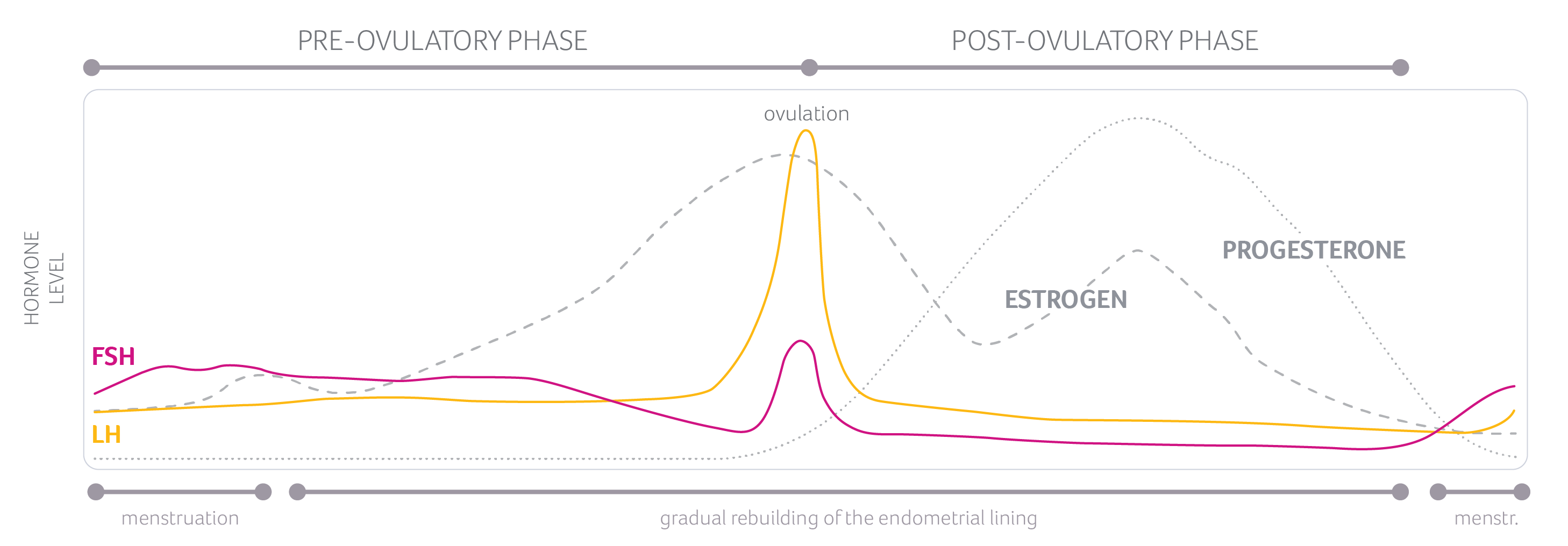
Consider taking a pregnancy test if your BBT stays high for more than 18 days after ovulation. HCG from the placenta of an implanted fetus sustains the corpus luteum, so your BBT remains high during early pregnancy. Prolonged high BBT isn’t a sure way to detect a pregnancy, so you have to take a test.
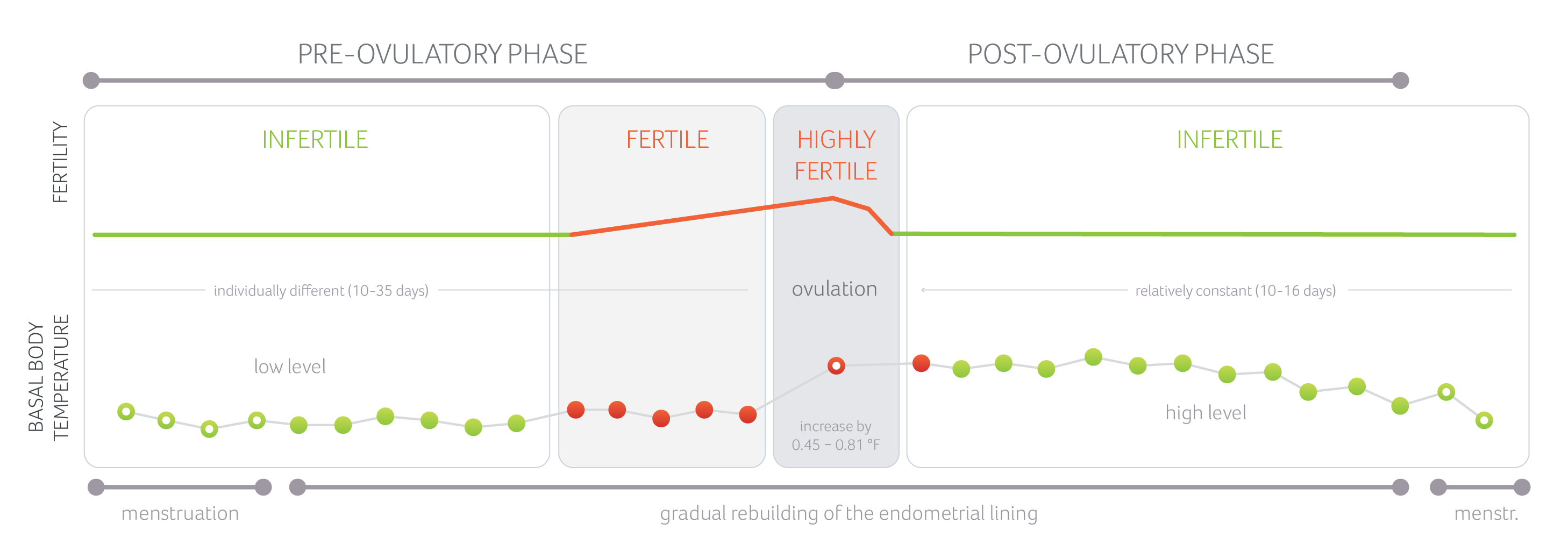
How do you check your basal body temperature?
Measure your basal body temperature each morning immediately after waking up by placing a thermometer under your tongue. Specialized devices such as the Daysy fertility tracker are much better for monitoring your BBT than regular thermometers because their sensitive sensors can precisely detect slight temperature changes.
You must take your BBT right after you wake up. Don’t lay in bed for a few minutes, or take a sip of water first. This is because your body resets to the lowest possible temperature when you sleep. If you wait or move about, your body temperature goes up as your metabolism increases. We encourage you to get at least 3 to 4 hours of sleep the night before. Keep your Daysy tracker right beside your bed, so you don’t have to get up to get it in the morning. Just reach over, grab it, and stick it in your mouth.
When using your Daysy fertility tracker, ensure you follow the instructions to cut out errors. It’s easy to use, only takes about a minute each morning, and you can carry on with your day. Here’s an easy guide to checking your basal body temperature with your Daysy fertility tracker:
- Activate — Once you’re up in the morning, reach over and grab your Daysy fertility tracker. Push the button once to turn it on and do it again to activate the device. The blue rotating lights show that your tracker is ready to take your temperature.
- Insert — Insert your activated tracker in your mouth. Stick the sensor under your tongue and close your mouth.
- Wait — It typically takes less than 60 seconds for Daysy to record your temperature. Blue swirling lights mean your device is still taking your temperature. Daysy will give off a little "beep beep" sound once it’s done.
If you’re unsure if Daysy recorded your temperature for the day, try reactivating your device. If your temperature was already taken, it won’t go back into temperature-taking mode. - Lights — After taking your temperature, Daysy lights up in different colors to tell you more about your cycle. Here’s what the colors mean:
- Red — Fertile or possibly fertile
- Red flashing — Possible ovulation
- Green — Infertile days
- Yellow — Daysy is still learning your cycle, or your cycle is fluctuating
- Red, green, yellow (blinking) — You may be pregnant
You’ll have more red and yellow days for the first few cycles, but this changes as you go on. Aim to measure your BBT daily, but if you miss a few days, don’t sweat it. This won’t affect the accuracy of your device. Daysy fertility tracker is backed by over 30 years of research to help you take control of your fertility.

To read more articles like this, sign up for our newsletter:
Sources
1. 8 Types of BBT Thermal Shift - Ferty9
2. Anovulation - Women & Infants Fertility Center
3. Reproductive hormone influences on thermoregulation in women
